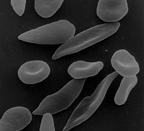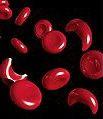Sickle cell anaemia is a classic haemoglobin disorder resulting from a single base mutation in the b-globin gene. Since the identification of the b-globin gene, haemoglobin disorders were among the first diseases to be considered for gene therapy. One approach is by insertion of a functional b-globin or b-like, fetal g-globin gene into a retroviral vector, which will be transduced into hematopoietic stem cells (HSCs). Retroviruses are RNA viruses that replicate through a DNA intermediate. The advantage of using retrovirus is that viral DNA can permanently integrate into the chromosomal DNA. Viral genes can then be replicated during the cell cycle and subsequently passed to daughter cells (Buchschacher, Jr. and Wong-Staal, 2000). Hematopoietic stem cells (HSCs) are pluripotent cells from bone marrow. They can extensively self-renew and can differentiate into any one of the blood cell lines. It has been shown in animal models that sickle cell condition could be improved substantially if expression of functional g-globin gene in red blood cells could be elevated by 9-16% (Blouin et al.,
2000), suggesting prospect of b-like globin gene transfer in sickle cell anaemia therapy.
The discovery of the locus control region (LCR) was a great step towards the success of gene therapy for sickle cell anaemia. The LCR for the b-globin gene cluster was defined as a series of DNAase I hypersensitive sites in the ~50 kb of DNA upstream from the b-globin locus (Grosveld et al., 1987). Using transgenic mice models, Grosveld et al. (1987) demonstrated that the hypersensitive sites had powerful erythroid-specific enhancer activity by allowing the chromatin of b-globin locus accessible to trans-acting transcription factors. These observations led to the hope that inclusion of minimal core hypersensitive fragments of the LCR could lead to position-independent expression of globin vector. However, the LCR/b-globin retroviral vectors exhibited...


